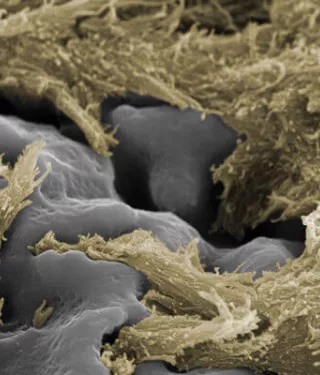
The implant surface and long-term survival
Prof. Wennerberg’s recent systematic review evaluates the reported survival rate and marginal bone loss of implants with modified surfaces, including Nobel Biocare’s TiUnite implant surface, after 10 years or longer. Here, she goes into detail about the findings of the study.
With decades of research under her belt, Professor Ann Wennerberg has been established as one of the foremost experts on dental implant surfaces. Her recent systematic review evaluates the reported survival rate and marginal bone loss of implants with modified surfaces, including Nobel Biocare’s TiUnite implant surface, after 10 years or longer.1 Here, she goes into detail about the findings of the study.

Professor Wennerberg, could you please give us a brief overview of your study and what you sought to find out?
Professor Wennerberg: I’ve conducted research into implant surfaces for the last 25 to 30 years, with many of these earlier studies measuring and characterizing surface topography in particular. As I’ve progressed, I have found that there is a strong interest in clinical follow-up studies. It’s one thing to achieve good results when testing on animals, but what dental professionals really want to know is: what was the clinical outcome of different implant surfaces?
That was the real question that this study sought to investigate – and not just following up on short-term outcomes, but having a long-term perspective. We had noticed that, in the early literature on the topic, moderately rough surfaces were reported to provide the implant with faster and firmer osseointegration than machined surfaces. However, there were also some concerns that these moderately rough surfaces were more prone to harbor plaque and microbiota, potentially leading to mucositis and other negative side effects.
Therefore, we wanted to know what actually happened to implants with moderately rough surfaces after a long period of being in use. To do so, a systematic review of 62 clinical studies was performed. To meet our criteria, each of these studies had to report a number of patients who had undergone prosthetic rehabilitation supported by dental implants and who had been followed up for at least 10 years.
What were the key findings of your study? Was there anything that surprised you?
Professor Wennerberg: Well, there was a mixture of both expected and surprising findings. Titanium plasma-sprayed surfaces, for example, showed more bone resorption than other implant surfaces, which we expected to see. But what surprised us was that anodized implant surfaces like Nobel Biocare’s TiUnite demonstrated significantly better survival rates than any other implant surface in all statistical analyses included in this study.
Is implant surface a key variable for the long-term survival rate and marginal bone loss of an implant, and how does its roughness impact this?
Professor Wennerberg: That’s a difficult question to answer. I think implant surface is a key factor, but there are many other compounding factors to consider. The studies we reviewed presented many different loading applications, were over different time periods and so on, and these differences can impact findings. Nevertheless, we were pleased with the study given the time we had, in which we’ve found a significant difference that speaks in favor of TiUnite’s anodized implant surface.
Is there any surface modification process that triggers special risks such as contamination?
Professor Wennerberg: As mentioned, moderately rough implant surfaces have been discussed as possibly harboring microbiota and allowing other particles to be released. In no way does this study support such statements, which are mainly based on animal or in vitro studies. We found that in the long-term – more than 10 years – the TiUnite implant surface functions very well.
Do you think clinicians would need to know anything specific about the different surfaces on the market when choosing which to use?
Professor Wennerberg: I think that you should select an implant that has documented clinical results. I think that we have enough support to say that a moderately rough surface is more forgiving in terms of achieving primary stability.
It is also important that the manufacturer has control over their process so that the clinician knows exactly what they are choosing and how clean the modified implant surface is. Various studies have shown that many of the not-so-well documented implant surfaces possess a high degree of contamination. This could be related to the manufacturing process, the packaging of the implants, differing cooling lubricants and so on, but it is obviously something that should, and can be avoided by having a proven and reliable manufacturing method.
TiUnite image courtesy of Peter Schupbach ltd.
References
1. Wennerberg A, Albrektsson T, Chrcanovic B. Long-term outcome of implants with different surface modifications. Eur J Oral Implantol. 2018;11(Suppl1):S123-S136